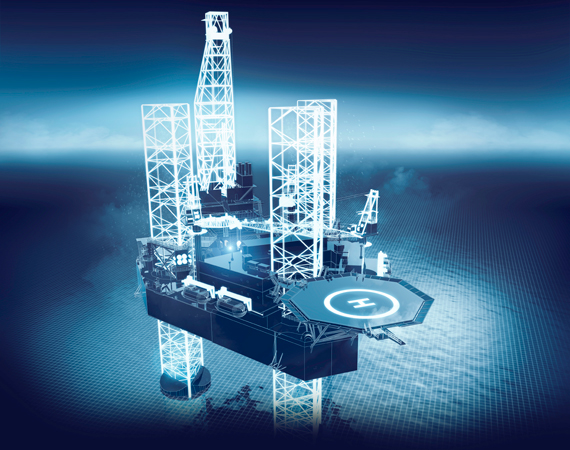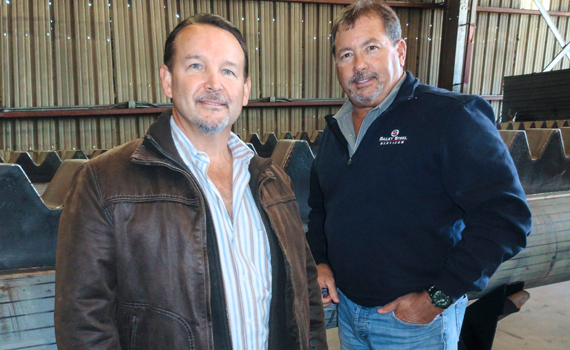Exploring the offshore market
The opportunities for the use of high strength steel in offshore applications are endless. Besides oil and gas platforms, it is ideal for equipment positioned high up – and, therefore, which needs to be lighter – on rigs or boats, such as drill towers and production equipment like winches, compressors or pumps. Structural steels are dominating but there are also a number of Hardox opportunities for guide plates, deck reinforcements and cargo holds.

The main task of the jack-up legs JSA Group produces is to raise and lower the hull clear of the water.
And, then there’s also the renewable or “green” energy market where high strength steel could be used in offshore wind, wave and tidal turbines.
“Now is a golden time to look into these opportunities for efficiency,” says Joakim Nyström, SSAB’s Key Segment Manager for Energy & Offshore. “High strength steel may not work in every application but in the offshore team – including both SSAB Europe, SSAB Special Steels and SSAB Americas – we have a fantastic offer. We have a full range of classed grades from Grade A to Strenx 700 OME with ABS EQ 70 approval in combination with great prefabrication possibilities.”
One particularly successful offshore product has been building legs for jack-up rigs, where SSAB high-strength steel is used for chords on each jack-up leg assembly.
“The high strength steel is also used in lift-boat applications,” says Chris Gasper, General Manager at SSAB in USA. “These legs – up to 150 meters long – require strength in order to stabilize the boat for performing maintenance and lifting operations for the rig at sea.”
The US operations have been able to offer customers a “One-Stop-Shop” together with manufacturing company JSA Group. Offshore jack-up drilling rigs and jack-up lift-boats are very complex structures incorporating a wide variety of materials, machinery and equipment.
“The fundamental task of these units is the ability to raise and lower the hull clear of the water, by means of a rack and pinion driven system supporting and elevating the heavy platform numerous times over the life of the rig,” says JSA President Jay Fogal.

From left: Jay Fogal, President, and Karl Oswald, CEO, at JSA.
Production of the jack-up leg components involves heavy fabrication of high strength steel, flame cut and/or machined parts and the steel forming of pipes, transitions and other heavy components.
“In 2012, our Houston-based JSA were searching for a domestic source for high-quality quenched and tempered steel for offshore jack-up rig legs. We met with a team from SSAB in Houston and later visited their steel mills in both Mobile, Alabama, and Borlänge, Sweden,” says Fogal.
“We were highly impressed that the Mobile mill had adopted many of the quality aspects that SSAB was known for at its Swedish operation. Since that time, our group has purchased several thousand tons in the thickness range of 1” to 2” which were produced in both their US and Swedish mills. We were also thoroughly impressed with the flatness, surface condition and weldability of the steel. In particular, the extraordinary consistency in chemical and mechanical properties of all the plates made for a consistent end product,” explains Fogal.
These factors coupled with consistent timely deliveries of quality products and materials have formed the foundation for a lasting and mutually satisfactory relationship between SSAB and JSA.
Until now, the use of high strength steels in offshore products has been low. According to Nyström it’s because the industry has not prioritized on making its products lighter, plus the fact that regulations governing the materials used in offshore designs are very tight.
“But times are changing,” he explains. “The market is more interested in weight reduction opportunities now compared to ten years ago. The extreme low oil price force the market to find every possibility for increasing efficiency and reducing cost, and using high strength steels is one.”
There are two major challenges though. The first is related to the harsh conditions of operating offshore. The advanced load case made by waves and wind cause torsion, twist, horizontal and vertical stresses that together with salt and humidity affect the steel structures.
The second is classification rules that state limitations for steel strength in ship-, platform hulls and fixed platforms to maximum 500 MPa, the SSAB TM rolled high strength steels are here an opportunity. For secondary structures, machinery and equipment there is more freedom of material choice. Here we see great possibilities for our customers to use classed Strenx 700 OME and also normal Strenx 700. Even Strenx 960 can be used in unwelded structures with special approvals.
“We want to promote cold-forming and HFMI (High Frequency Mechanical Impact) treatment to remove the welds from the most critical areas and ensure they are as fatigue resistant as possible. In the past cold-forming was not allowed; now it can be used in the design as long as some extra tests are conducted to prove it is suitable for the application,” says Nyström.
SSAB’s offer to the offshore industry
• Extra high-strength steels: Strenx 700 OME for jackup legs, offshore cranes, lifting equipment, top side structures, drill towers. Strenx 960 for tension bars.
• Thermomechanically rolled high-strength steels: S420, S460, S500 with offshore specifications for platform structures, advanced ship hulls and ice breakers.
• Normal shipping and offshore grades from grade A to S355 MPa level: For platform structures and conventional ship hulls.
• Prefabrication: Plate finishing and prefabrication for custom sizing, weld preparation of edges, roll bending, press breaking, large tube forming and welding and profiles and hollow sections.
Text: Alannah Eames
This article has been published on SSAB World magazine’s issue 1/2016.
Find the whole magazine in PDF format.